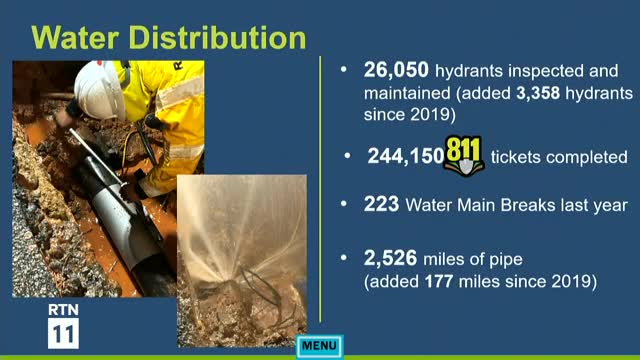Raleigh Water proposes rate increase to support capital improvement projects
April 08, 2025 | Raleigh, Wake County, North Carolina
Thanks to Scribe from Workplace AI , all articles about North Carolina are free for you to enjoy throughout 2025!

This article was created by AI using a video recording of the meeting. It summarizes the key points discussed, but for full details and context, please refer to the video of the full meeting. Link to Full Meeting
The water distribution division reported impressive statistics, including the inspection and maintenance of over 26,000 fire hydrants and the addition of more than 3,000 hydrants in the past five years. The utility locating group handled over 244,000 tickets to ensure infrastructure safety, while the water treatment division conducted over 23,000 laboratory samples to guarantee safe drinking water. These efforts reflect the city's proactive approach to public safety and infrastructure management.
The fiscal year 2026 operating budget is projected at over $372 million, with 48% allocated for operating costs and 52% for capital projects. Notably, the budget includes a significant focus on pipe replacement and water treatment plant improvements, with the E.M. Johnson Water Treatment Plant expansion expected to increase capacity from 82 million gallons per day to 120 million gallons per day.
Council members discussed the need for a new water source, with projections indicating that Raleigh may require additional supply by 2045 if growth trends continue. The Little River Reservoir has been identified as a potential source, capable of yielding between 17 and 22 million gallons per day, which would provide approximately 20 years of capacity.
In terms of financial planning, the council reviewed proposed rate increases for water and wastewater services. The adjustments aim to meet financial covenants and ensure the sustainability of services. For the median single-family home, the proposed changes would result in a total water and sewer bill increase of approximately 3.5%.
Additionally, the city’s customer assistance program has successfully supported nearly 2,700 customers with $535,000 in aid, demonstrating a commitment to community support during challenging times.
As the council prepares for final budget approval, the discussions highlighted the importance of strategic planning in addressing both current needs and future growth, ensuring that Raleigh remains equipped to provide reliable water and sewer services to its residents.
Converted from Raleigh City Council Budget Work Session - April 7, 2025 meeting on April 08, 2025
Link to Full Meeting
Comments
View full meeting
This article is based on a recent meeting—watch the full video and explore the complete transcript for deeper insights into the discussion.
View full meeting